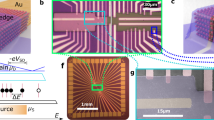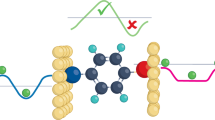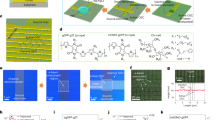Abstract
The use of individual molecules as functional electronic devices was proposed in 1974 (ref. 1). Since then, advances in the field of nanotechnology have led to the fabrication of various molecule devices and devices based on monolayer arrays of molecules2,3,4,5,6,7,8,9,10,11. Single molecule devices are expected to have interesting electronic properties, but devices based on an array of molecules are easier to fabricate and could potentially be more reliable. However, most of the previous work on array-based devices focused on two-terminal structures: demonstrating, for example, negative differential resistance8, rectifiers9, and re-configurable switching10,11. It has also been proposed that diode switches containing only a few two-terminal molecules could be used to implement simple molecular electronic computer logic circuits12. However, three-terminal devices, that is, transistors, could offer several advantages for logic operations compared to two-terminal switches, the most important of which is ‘gain’—the ability to modulate the conductance. Here, we demonstrate gain for electronic transport perpendicular to a single molecular layer (∼10–20 Å) by using a third gate electrode. Our experiments with field-effect transistors based on self-assembled monolayers demonstrate conductance modulation of more than five orders of magnitude. In addition, inverter circuits have been prepared that show a gain as high as six. The fabrication of monolayer transistors and inverters might represent an important step towards molecular-scale electronics.
This is a preview of subscription content, access via your institution
Access options
Subscribe to this journal
Receive 51 print issues and online access
$199.00 per year
only $3.90 per issue
Buy this article
- Purchase on Springer Link
- Instant access to full article PDF
Prices may be subject to local taxes which are calculated during checkout




Similar content being viewed by others
References
Aviram, A. & Ratner, M. A. Molecular rectifiers. Chem. Phys. Lett. 29, 277–283 (1974).
Goldhaber-Gordon, D., Montemerlo, M. S., Love, C. J., Opiteck, G. J. & Ellenbogen, J. C. Overview of nanoelectronic devices. Proc. IEEE 85, 521–540 (1997).
Tans, S. J., Verschueren, A. R. M. & Dekker, C. Room-temperature transistor based on a single carbon nanotube. Nature 393, 49–52 (1998).
Martel, R., Schmidt, T., Shea, H. R., Hertel, T. & Avouris, P. Single- and multi-wall carbon nanotube field-effect transistors. Appl. Phys. Lett. 73, 2447–2449 (1998).
Joachim, C., Gimzewski, J. K. & Aviram, A. Electronics using hybrid-molecular and mono-molecular devices. Nature 408, 541–548 (2000).
Andres, R. P. et al. “Coulomb staircase” at room temperature in a self-assembled molecular nanostructure. Science 272, 1323–1325 (1996).
Dunbar, T. D. et al. Combined scanning tunneling microscopy and infrared spectroscopic characterization of mixed surface assemblies of linear conjugated guest molecules in host alkanethiolate monolayers on gold. J. Phys. Chem. B 104, 4880–4893 (2000).
Chen, J. et al. Room-temperature negative differential resistance in nanoscale molecular junctions. Appl. Phys. Lett. 77, 1224–1226 (2000).
Metzger, R. M. Electrical rectification by a molecule: The advent of unimolecular electronic devices. Acc. Chem. Res. 32, 950–957 (1999).
Collier, C. P. et al. A [2]catenane-based solid state electronically reconfigerable switch. Science 289, 1172–1175 (2000).
Collier, C. P. et al. Electronically configurable molecular-based logic gates. Science 285, 391–394 (1999).
Ellenbogen, J. C. & Love, J. C. Architectures for molecular electronic computers: 1. Logic structures and an adder designed from molecular electronic diodes. Proc. IEEE 88, 386–426 (2000).
Horowitz, G. Organic field-effect transistors. Adv. Mater. 10, 365–377 (1998).
Forrest, S., Burrows, P. & Thompson, M. The dawn of organic electronics. IEEE Spect. 37, 29–34 (2000).
Di Ventra, M., Pantelides, S. T. & Lang, N. D. The benzene molecule as molecular resonant-tunneling transistor. Appl. Phys. Lett. 76, 3448–3450 (2000).
Tour, J. M. Molecular electronics. Synthesis and testing of components. Acc. Chem. Res. 33, 791–804 (2000).
Joachim, C. & Gimzewski, J. K. An electromechanical amplifier using a single molecule. Chem. Phys. Lett. 265, 353–357 (1997).
Sze, S. M. Semiconductor Devices: Physics and Technology 431–486 (Wiley, New York, 1985).
Rodgers, T. J. & Meindl, J. D. VMOS: High-speed TTL compatible MOS logic. J. Solid State Circ. 9, 239–250 (1974).
Hergenrother, J. M. et al. in International Electron Devices Meeting 2000. Technical Digest 65–68 (IEEE, Piscataway, 2000).
Hong, S. et al. Molecular conductance spectroscopy of conjugated, phenyl-based molecules on Au(111): the effect of end groups on molecular conduction. Superlattices Microstruct. 28, 289–303 (2000).
Tour, J. M. Conjugated macromolecules of precise length and constitution. Organic synthesis for the construction of nanoarchitectures. Chem. Rev. 96, 537–553 (1996).
Dodabalapur, A., Torsi, L. & Katz, H. E. Organic transistors: two-dimensional transport and improved electrical characteristics. Science 268, 270–271 (1995).
Di Ventra, M., Pantelides, S. T. & Lang, N. D. First-principle calculation of transport properties of a molecular device. Phys. Rev. Lett. 84, 979–982 (2000).
Natori, K. Ballistic metal-oxide-semiconductor field effect transistor. J. Appl. Phys. 76, 4879–4890 (1994).
Emberly, E. G. & Kirczenow, G. Multiterminal molecular wire systems: A self consistent theory and computer simulations of charging and transport. Phys. Rev. B 62, 10451–10458 (2000).
Chen, J. et al. Electronic transport through metal-1,4-phenylene diisocyanide-metal junctions. Chem. Phys. Lett. 313, 741–748 (1999).
Karl, N. in Semiconductors Vol. 17i (eds Madelung, O., Schulz, M. & Weiss, H.) 106–218 (Landolt-Börnstein, New Series, Springer, Berlin, 1985).
Schön, J. H., Kloc, Ch. & Batlogg, B. Fractional quantum Hall effect in organic molecular semiconductors. Science 288, 2338–2340 (2000).
Burshtein, Z. & Williams, D. F. Temperature dependence of carrier generation, and transport in para-terphenyl above and below the 180 K phase transition. J. Chem. Phys. 68, 983–988 (1978).
Acknowledgements
We thank D. Abusch-Magder, E. Bucher, F. Capasso, Ch. Kloc, J. A. Rogers, M. Schön and E. A. Chandross for many valuable discussions. J.H.S. thanks E. Bucher for the use of the laboratory during his stay at the University of Konstanz. H.M. is grateful to F. Wudl of the University of California at Los Angeles for his support of an internship at Lucent Technologies.
Author information
Authors and Affiliations
Corresponding author
Rights and permissions
About this article
Cite this article
Schön, J., Meng, H. & Bao, Z. Self-assembled monolayer organic field-effect transistors. Nature 413, 713–716 (2001). https://doi.org/10.1038/35099520
Received:
Accepted:
Issue Date:
DOI: https://doi.org/10.1038/35099520
This article is cited by
-
Single molecular shuttle-junction: Shot noise and decoherence
Frontiers of Physics (2015)
-
The interface electronic structure of thiol terminated molecules on cobalt and gold surfaces
Journal of Materials Science (2006)
-
Solution phase electron transfer versus bridge mediated electron transfer across carboxylic acid terminated thiols
Journal of Solid State Electrochemistry (2006)
Comments
By submitting a comment you agree to abide by our Terms and Community Guidelines. If you find something abusive or that does not comply with our terms or guidelines please flag it as inappropriate.



